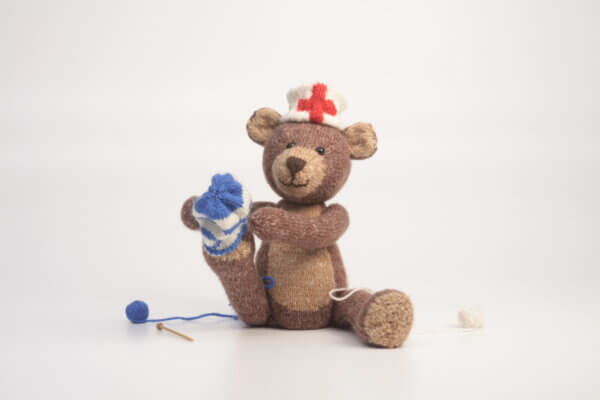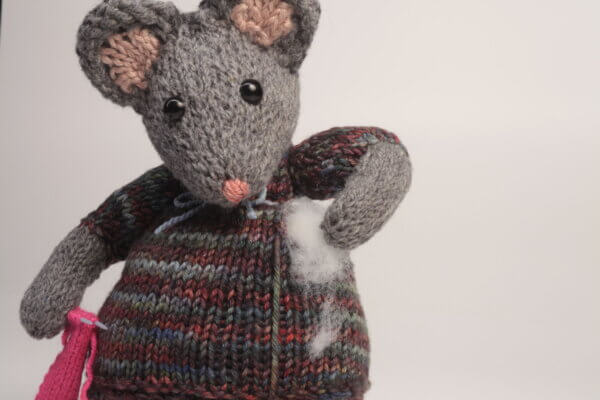Samantha Moore Unravels the Making of Visible Mending
Visible Mending is the latest film from director Samantha Moore.
Known for mixing subjects with their material, Sam’s previous work Bloomers interviewed workers at a lingerie factory and animated their words directly onto the knickers they made. With Visible Mending Moore returns to the documentary format and explores the curative world of knitting and how it has been employed by people to counter, escape or reflect upon their own lived experiences.
The film itself explores the quaint perception of knitting by putting the words of the interviewed subjects to charming knitted characters. The director is careful to delve deeper than the cosy and welcoming perception that the puppets emanate, make no mistake this film does not trivialise the subjects through an overly twee veneer and instead expands upon the importance of knitting as a powerful, therapeutic tool in a way that only animated documentary can.
This is the director’s first foray into stop motion animation, working with Second Home Studios (Tweedy and Fluff) to bring to life the delightful characters whose experiences take centre stage in this film. We caught up with Sam Moore to find out more about her BAFTA nominated film.
No offence to narrative led storytelling but it’s refreshing to see a documentary make it through to the BAFTA nominations! Animation has a wonderful way of conveying big concepts as your own work attests to. What draws you to animation above live action?
I like the thoughtful making process of animation. It takes ages to do (I don’t know if you have heard…) but that turns into a positive with documentary because it allows lots of time to develop and strengthen relationships with the interviewees. It also allows the interviewees to have agency within the frame itself – they can help influence their own representation thorough drawing, or in this case knitting! In Visible Mending several of the interviewees made their own knitted puppets, and all of them chose the patterns that we used.
There is an amazing connection between yourself and the subjects, the interviewees knitted or chose their own characters and rather than anonymising the documentary subjects you have put them front and centre at the end of the production, was this to pay tribute to the participants?
I spent 3 years in research and development, not with a specific film in mind but knowing I wanted to make something around knitting, and just talking to the knitters, doing an animation workshop so they could understand my process, and knitting with them. It meant that we had lots of material to draw from, as one of the knitter’s (Kate’s) husband was a retired radio technician so he could record our chats. After we got commissioned by BFI to make the film, and started the production process, Kate was sadly diagnosed with terminal liver cancer so she invited me back to reinterview her in the light of that. The final section of the film, when she says, “Shall we have a coffee?”, you can hear me enthusiastically agreeing! I was so happy that we had completed the interview, and so sad as I knew it would be my last one with Kate. She never saw the film completed but she was so supportive throughout and Pete continued to be a big part of the film, recording the enhanced audio description.
There must have been a wealth of very personal and heartfelt material to draw from your subjects, how did you make those tough decisions and trim down the audio?
Oh that was so hard. I had so many stories but with limited time I had to really take a position on the material and stick to it. I chose to focus on their age – they were all around or above retirement age; 60s, 70s and 80s. There was a particular perspective that comes with that, which I thought was interesting. I felt like knitters and crocheters of that age are routinely ignored and undervalued so this was a way of redressing the balance. I also had some people I really wanted to include the perspective of – Betsan Corkhill, physiotherapist and writer about knitting as therapeutic aid, Lorna Hamilton-Brown, artist, activist, and all round textile goddess, and Mike Donnelly who is one of the most generous and kind knitters I have met.
As a mixed media, but predominantly 2D animator how did you find the process of collaborating with Second Home Studios to realise the production in stop motion?
It was a fascinating learning curve! One of the major issues was that I made the animatic in 2D drawn form, but that didn’t translate seamlessly into 3D stop motion. In 2D gravity and space are only relevant if you want them to be, whereas in stop motion you are prey to the pesky laws of physics. I learned so much!
As a 2D animator, what did you learn from working in stop motion – have you been put off it for life or would you do it again in a heartbeat?
The next two film ideas that I have are definitely stop motion, and I’m like: “who even am I?” I do love to watch stop motion, and I have long admired Second Home Studios work as being immaculately animated, but it was not something I aspired to making myself before now. Since making Visible Mending I have had a zillion ideas about different ways of working with it. I was in the lucky position of being able to direct it rather than having to learn the skill myself. Working with Adam Farish, Jess Mehler and Dan Wilkinson (the stop motion animators) was such a pleasure, they’re all hugely talented. It was also a revelation working with model makers Amanda Haas and Laura Watson, who had such a vast knowledge of making, and were really generous to work with.
The film was funded by the BFI, is short, animated filmmaking in the UK in a robust state at the moment?
The BFI Short for funding was a wonderful opportunity for me to make a leap with my practice. I will be forever grateful to the panel, including Lizzie Francke, Helen Brunsden and Jez Stewart, for having faith in me to give me this proportionally large pot of funding and allow me to take my work into a new direction (stop motion). It has been a revelation and given that two of the 3 BAFTA nominees this year were made through the scheme (Wild Summon was also BFI Short Form) I think they have shown vision and faith in animation short form. Not to mention Lizzy Hobb’s wonderful film The Debutante which was Oscar short listed last year. Long may it continue!
This year’s BAFTA ceremony takes place on Sunday 18 February on BBC One and iPlayer and broadcast around the world including on Britbox in North America.



